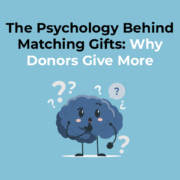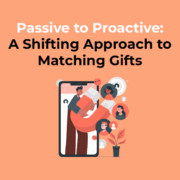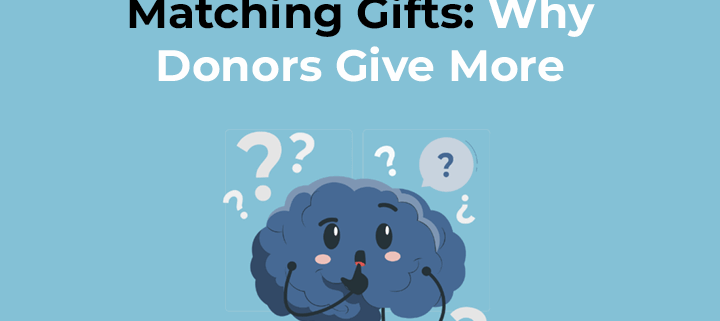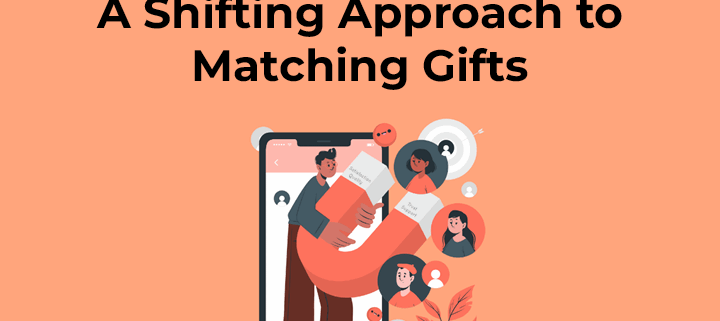Matching gifts are one of the most overlooked revenue opportunities in nonprofit fundraising. Every year, billions of dollars in corporate matching gift funds go unclaimed—not because donors are unwilling to give more, but because they don’t know they can. And too often, nonprofits leave that money on the table by taking a passive approach to matching gifts: simply hoping donors will take the initiative on their own.
But things are changing. Today, leading nonprofits are shifting from passivity to proactivity in their matching gift strategies—and seeing a major return on investment by doing so. After all, moving to intentional outreach can mean the difference between a donor giving once… and that gift being doubled—or even tripled—with minimal extra effort.
In this post, we’ll explore what it looks like to adopt a proactive approach to matching gifts, why it matters now more than ever, and how your team can take simple steps to start capturing more match revenue right away.
Specifically, we’ll cover:
- The Largely Unclaimed Matching Gift Opportunity
- Understanding the Passive Approach: What’s Holding You Back
- Making the Shift: Being Proactive in Your Approach to Matching Gifts
- Real Successes: 3 Orgs Taking a Proactive Approach to Matching Gifts
- Getting Started: First Steps Toward Proactivity
Make the most of your mission—don’t let corporate philanthropy dollars slip through the cracks. Take the first step toward a more proactive approach, and start turning more of your donations into double the impact.
Let’s begin!
The Largely Unclaimed Matching Gift Opportunity
Matching gifts are one of the most powerful—yet most underutilized—tools in a nonprofit’s fundraising toolkit. While many companies offer generous matching gift programs, most of this potential funding never reaches the nonprofits it’s meant to support.
The numbers (AKA Double the Donation’s matching gift statistics) speak for themselves:
- $2–3 billion in matching gifts are donated annually, but an estimated $4–7 billion goes unclaimed each year.
- 65% of Fortune 500 companies offer matching gift programs, yet 78% of donors are unaware if their employer has one.
- Of donors who are match-eligible, only 1 in 10 actually submit a matching gift request.
- 84% of donors say they’re more likely to give if they know a match is available, and 1 in 3 say they would give a larger gift if matching is an option.
This gap isn’t due to a lack of generosity—it’s a visibility problem. Most donors simply don’t know they can double their impact with a few extra clicks. And without proactive marketing, follow-up, and simple submission guidance, those dollars stay with the employer instead of supporting your mission.
For nonprofits, this presents a clear opportunity: if you can close the awareness gap and simplify the process, you could significantly increase fundraising revenue without asking donors to give more out of pocket.
Understanding the Passive Approach: What’s Holding You Back
If your organization has only dabbled in matching gifts thus far, you’re certainly not alone. Most nonprofits are stuck in what we’d call the passive stage of matching gift promotion. And while it’s easy to think this is a strategic choice, the reality is more nuanced: it’s usually about limited capacity rather than lack of interest.
Here are a few of the most common reasons organizations like yours default to a passive approach to matching gifts:
1. Limited Staff Bandwidth
According to Nonprofit Source, a reported 80% of nonprofits have difficulty building strong workplace giving strategies with limited staff and resources. Many fundraising teams are already stretched thin, juggling tasks and activities like campaigns, stewardship, events, and reporting—just to name a few. As a result, matching gifts often fall to the bottom of the list simply because there’s no one with enough dedicated time to manage it.
2. Lack of Technical Resources or Tools
Some nonprofits mistakenly assume that promoting matching gifts requires a complex tech stack or manual tracking, which can feel overwhelming without the right systems in place. Lacking automation, managing match eligibility, follow-ups, and employer-specific instructions becomes a logistical burden—especially for smaller teams.
3. Unclear Ownership
In many organizations, it’s unclear who “owns” matching gifts. Is it development? Donor relations? Marketing? As a result, the responsibility gets diluted—or overlooked entirely. When no one is directly accountable for growing the program, it tends to stagnate.
4. Underestimating the Opportunity
Finally, some organizations simply don’t realize how much money they’re leaving on the table. If you’ve never actively promoted matching gifts, you might not be aware of the revenue potential. And without data or past success to point to, it’s hard to make the case for prioritizing the effort.
While these challenges are valid, the cost of staying passive is high. The good news? A proactive approach doesn’t have to mean more manual work. With automation tools like Double the Donation and smarter marketing strategies, even small teams can build a scalable, high-impact matching gift program.
Making the Shift: Being Proactive in Your Approach to Matching Gifts
So you’ve realized your organization may be taking a passive approach to matching gifts—and missing out on significant funding and engagement opportunities. Now what?
We recommend that you start by being more intentional, consistent, and strategic in how you communicate about matching gifts. When you take a proactive approach, you make it easy for donors to take the next steps—and you position your organization to capture significantly more match revenue.
Here’s what a proactive strategy looks like in practice:
1. Train Staff and Engage Leadership
Proactivity means building internal champions, and that starts with internal marketing. For the best results, be sure to train your fundraising, marketing, finance, and donor relations staff to understand matching gifts and promote them confidently throughout their efforts.
From there, you can share impact data regularly with leadership to reinforce the value of the program and secure continued support.
2. Identify a Matching Gift Point Person
Assign someone on your team—whether they’re in fundraising, donor relations, or marketing—to take ownership of matching gift efforts. This doesn’t need to be a full-time role, but having one person responsible for tracking performance, updating messaging, and liaising with vendors will help drive consistency and growth.
3. Promote Matching Gifts Before, During, and After the Donation
For the best results, make matching gifts a significant part of your entire donor journey—from the initial point of contact to the last follow-up reminder you send. This can mean:
- Mentioning matching gifts in appeals and newsletters
- Including company search tools directly on your donation form
- Adding a reminder to the donation confirmation page
- Following up with tailored, company-specific instructions to eligible donors
All in all, this repetition and consistent promotion ensure more donors take action, and more gifts ultimately get matched.
4. Automate Eligibility Checks and Follow-Ups
Tools like Double the Donation automatically identify donors who are match-eligible based on their email domain or employer, and then send personalized reminders with easy-to-follow instructions. This eliminates the need for manual tracking and removes friction for your donors.
By planning your outreach, using smart tools, and building awareness into your donor experience, you set the foundation for a program that grows over time—and brings in revenue you otherwise would have left on the table.
5. Market Far and Wide on Social Media
Your donors aren’t just checking email. They’re scrolling Instagram, clicking LinkedIn posts, and tapping through stories. That makes social media a powerful (and often underused) tool for driving awareness of matching gifts. But if you want to take a proactive approach, your messaging needs to meet donors where they are—and that includes their feeds.
Start by sharing educational information via social channels, and be sure to include a clear call to action driving users to your dedicated matching gifts page. From there, pair information with eye-catching graphics or videos that explain how easy it is to submit a match request.
6. Set a Simple Goal and Track Progress
Start by setting an achievable short-term goal to kick off your efforts—such as identifying 25 match-eligible donors, completing 10 submitted matches, or adding matching gift language to three communications. Then, track your progress on a regular basis to stay focused and motivated.
Starting with a few clear metrics makes it easier to celebrate early wins and build momentum.

Real Successes: 3 Orgs Taking a Proactive Approach to Matching Gifts
Shifting from a passive to a proactive approach to matching gifts isn’t just theoretical. Instead, it’s making a real difference for organizations of all sizes and missions. These three nonprofits are great examples of how intentional strategies, the right tools, and small process shifts can lead to major results.
National Multiple Sclerosis Society
What inspires this organization’s matching gift proactivity?
In their own words, “Double the Donation (a matching gift platform) empowers us to proactively reach out to donors. This can maximize the revenue potential of every gift. It also provides another touchpoint during connections.”
The National MS Society understands the value of timely, intentional donor engagement. By using Double the Donation’s matching gift tools to identify match-eligible donors and follow up proactively, they’ve transformed matching gifts into a key touchpoint within their broader stewardship strategy, helping to deepen relationships while increasing revenue.
They also include the following information on the organization’s donation form in order to help do so:

Watch the video below to learn more about how the nonprofit shifted its approach to matching gifts:
Maine Public
According to Maine Public, which also faced a lack of awareness as a critical stumbling block, “Double the Donation’s search function being able to be integrated seamlessly into our donation pages and our web pages made it easy for donors to learn how to access their companies’ matching dollars.”
For this public media organization, a big win came from reducing friction in the donor experience. That simple visibility shift helped turn untapped potential into actionable giving.
Watch the video below to learn more about how the nonprofit shifted its approach to matching gifts:
Greater Boston Food Bank
Finally, the Greater Boston Food Bank states that “Double the Donation Matching has become an important component of our fundraising, allowing us to maximize corporate matching opportunities in a simple and proactive way with little labor and maximum results.”
This organization proves that a proactive approach doesn’t have to be resource-intensive. With the right systems in place, Greater Boston Food Bank has created a high-efficiency process for identifying and driving matches, allowing their team to focus on impact while matching gifts work seamlessly in the background.
This includes an easy integration with the organization’s donation forms, which even lets the donor know to expect an email post-gift with instructions on how to submit a match. And if the individual provides their employing company from the giving page, their follow-up will be tailored to their employer! 
Interested in hearing even more stories from organizations shifting their approach to matching gifts? Check out Double the Donation’s complete case study compilation!
Wrapping Up & Additional Matching Gift Resources
The truth is, a passive matching gift strategy is no longer enough—not if you’re serious about unlocking the full potential of this revenue stream. By shifting your mindset from “waiting” to “nudging,” you position your organization to earn more without asking donors to dig deeper into their own wallets.
The best part? This shift doesn’t require a massive overhaul. A few small changes—automated follow-ups, stronger messaging, and the right software tools—can lead to substantial increases in matching gift revenue.
Looking for even more educational resources on matching gifts and beyond? Check out our recommended further reading:












